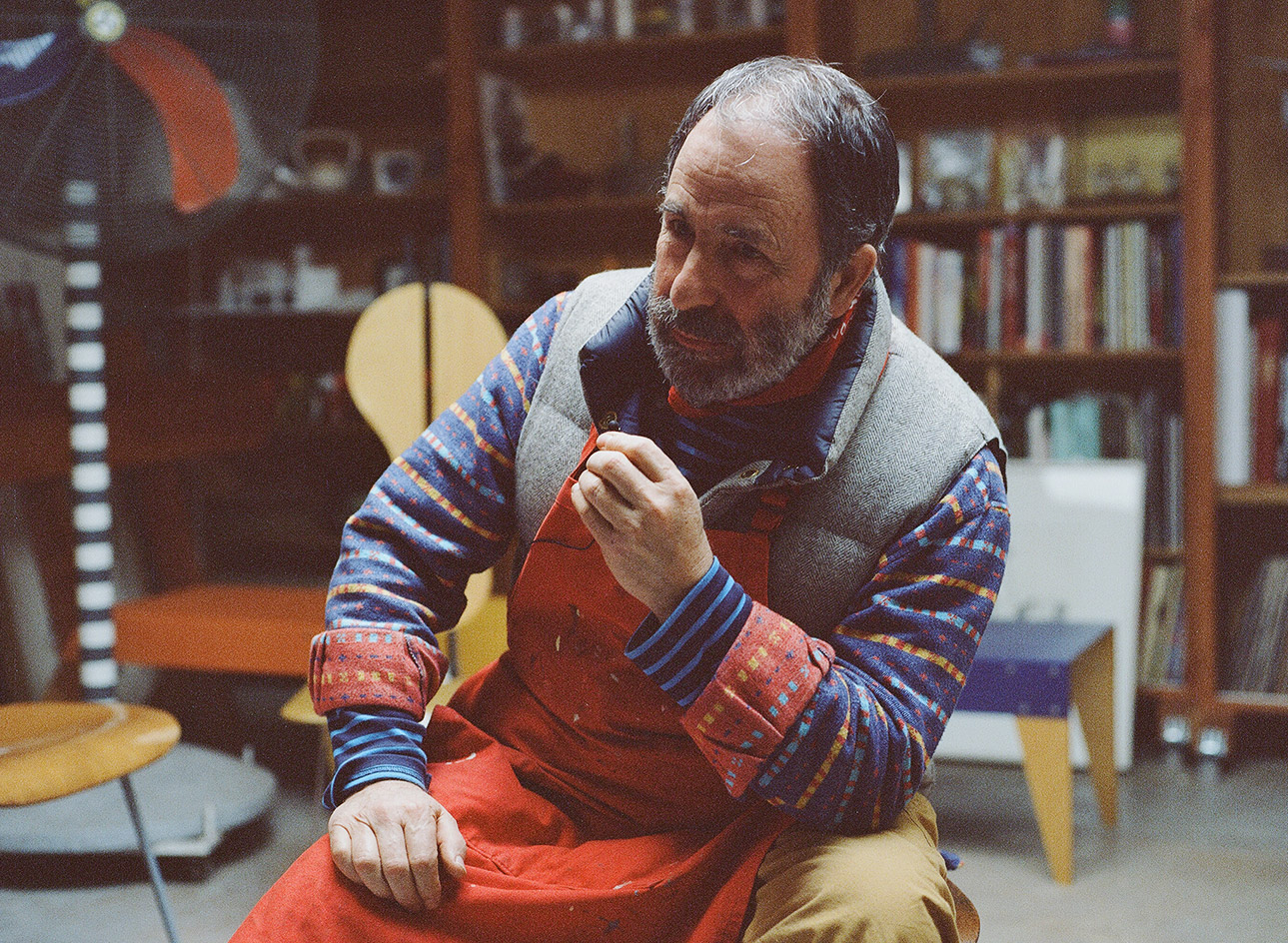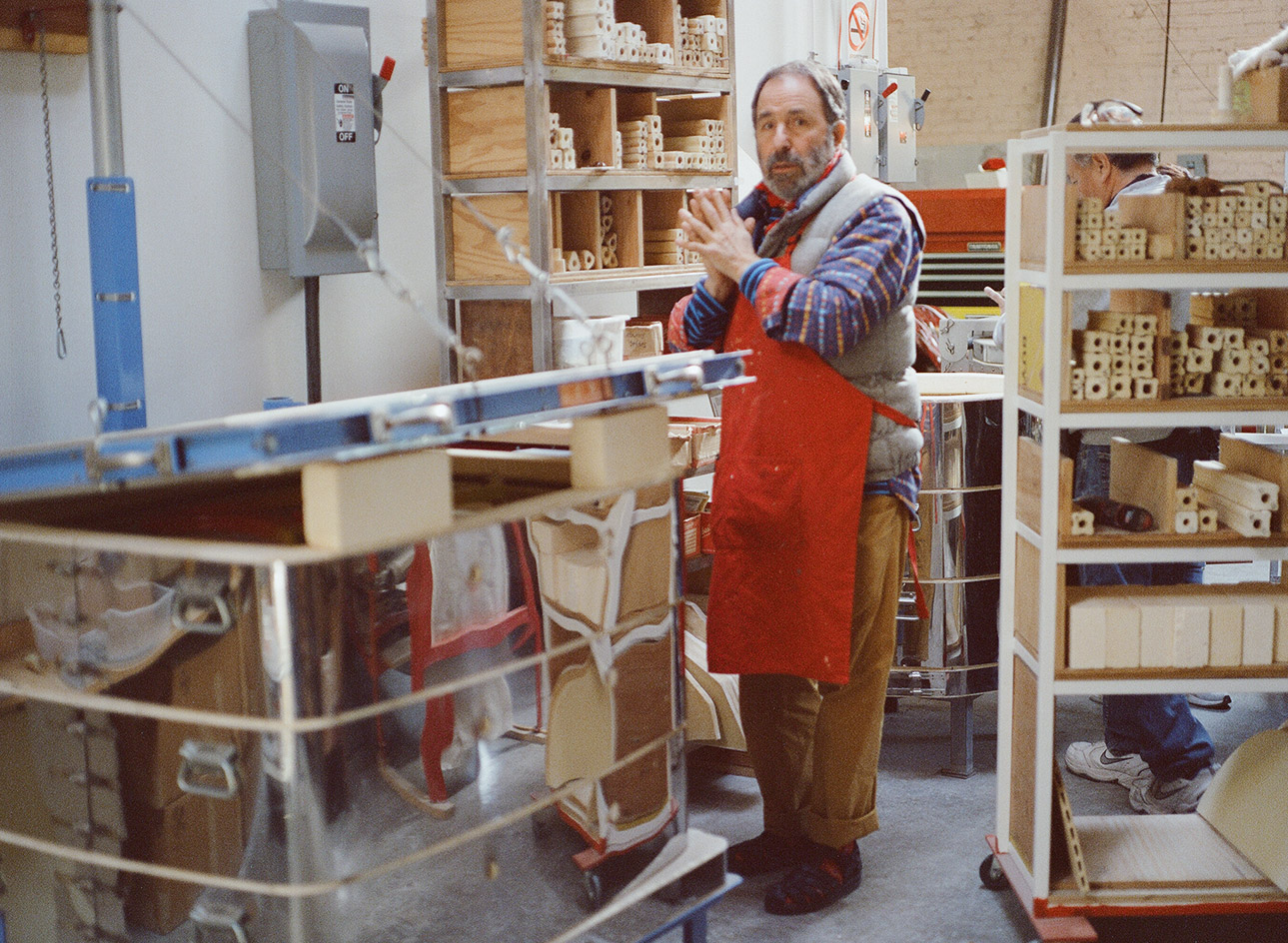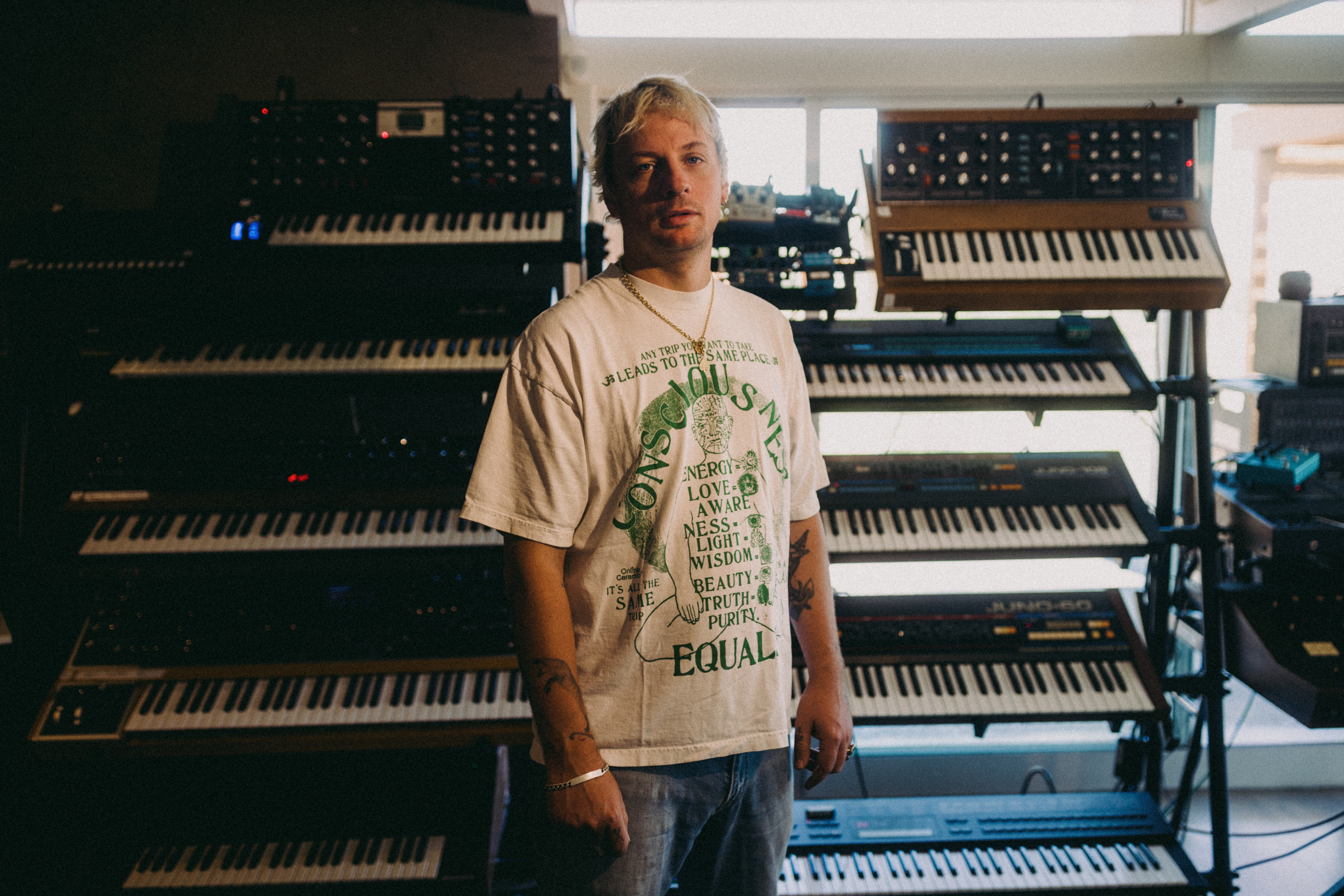A nostalgic look inside Memphis Group artist Peter Shire’s wonder-filled LA studio

‘A CD player can be put on random play. What if you had a design and a group of materials on random play, and all of them were coming out different? It would look like Memphis,’ muses Los Angeles artist Peter Shire in a new film, captured five days shy of his 70th birthday. The Memphis Group founding member is celebrated for his bright geometric teapots, sculptures, and furniture (as well as his sartorial penchant for stripes), with his off-kilter works dabbling on the right side of psychedelic kitsch. Directed by Harry Israelson and shot on Kodak Super 16mm, the nine-minute short Peter: on Fishing (watch below) takes us inside the artist’s Echo Park studio and home, where Shire opens up about what drove Memphis, our fear of colour, and the power of bad taste.
Shire was born in 1947 in Echo Park. His mother was a fourth-generation Californian and his father was a talented illustrator and carpenter. He yearned to be an artist from a young age, and later enrolled in the famed and now-defunct Chouinard Art Institute – although he was initially rejected from art school. ‘I am a maker of things, a hand-skills guy, so ceramics was my romantic vision. I wanted to be a potter wearing funky sandals and an apron,’ he told the Los Angeles Times in 2007.
In 1974, Shire made the two pieces – Auffen Gile and Gile Kilns – considered to be his first mature works in clay. These were sculptural, geometric interpretations of the traditional teapot, complete with ‘sun-bleached pastel glazes, uncanny angles, and a jumbled collage of parts’. Shire drew from the Bauhaus aesthetics, American craft, New Wave music, Space Age architecture, and Southern California ceramic artists like Peter Voulkos and Ken Price, his influences clearly steeped into his first teapot designs.
The artist’s early teapots caught the eye of Italian designer Ettore Sottsass, who was working in Los Angeles at the time. Sottsass found Shire’s teapots ‘fresh, witty, and full of information for the future’, and so Shire became the only American to join the Memphis design collective in Milan. There, Shire found a new creative outlet in furniture design, producing the iconic ‘Bel-Air’ chair (1984), among other bold pieces such as the ‘Peter sideboard’ (1987), ‘Peninsula’ table (1982), and ‘Hollywood’ coffee table (1983). ‘We were coming out of industrialism and entering into what is currently called the information age. I see Memphis and the approach to the pieces as a manual attempt at constructing things the way a computer could,’ says Shire.

Since the Memphis era, Shire has branched out into large-scale sculpture, works on paper, metalwork, and painting (on slabs of clay, of course). He has also completed commissions for public spaces and private buildings throughout Los Angeles, including colourful tile murals, while his work is included in a number of museum collections globally. Today, Shire works and lives with his wife in the modernist house that his parents built for themselves, not long after he was born.
We caught up with Israelson to find out more about his nostalgia-tinged film and dipping into Shire’s wonderland...
Wallpaper*: As a director, you work mainly on commercials as well as being known for your longtime collaboration with Toro y Moi. So how did you find yourself shooting a documentary on a Memphis Group artist?
Harry Israelson: Peter’s studio is actually on my street. I always walked past and never knew what was going on inside. Finally he hosted an open studio and we got to talking. After seeing him around the neighbourhood from time to time, I decided to ask if he was interested in making a film together.
W*: What was it like working with a larger than life character like Peter Shire?
HI: Peter is a very special person. Every machine, every toolbox, even his refrigerator, is airbrushed to fit within his bright colour palette. The entire world is curated and I found it to be incredibly inspiring. The very first thing we did was a three-hour audio interview; our conversation went all over the place, much in the way that his pieces are constructed, but somehow we always up ended back at an answer.

W*: Was your decision to shoot with Kodak Super 16mm a purely aesthetic one?
HI: Peter works across so many mediums; it felt appropriate to use a tactile medium such as film – something with texture, mirroring the paint and clay. I also like the limitations it provides. Shooting digitally means you can shoot endlessly. Film means you only have so much: here are the confines of your material now excel within those parameters. That thinking always fosters the best work for me.
W*: What were you trying to achieve with Peter: on Fishing?
HI: I wanted to make something that felt genuine, warm, and serious at the same time. The crew was small, just me and a few friends, and so the scale dictated the look, by way of necessity. There have been a lot of videos about Peter in the past but most offer a portrayal that is quite quirky, because the work is so playful; he’s a living legend whose contribution to American art is important.
W*: Tell us more about the music in the film. The title design, too, looks special...
HI: The score is by Jay Israelson, surprisingly of no relation (that I know of). Jay is a wonderful composer and pianist. The film needed to be romantic and so we pulled inspiration from impressionist composers like Debussy, Ravel, and Delius – even Gershwin and Bernstein had that same sentimental quality. The score features piano and synth because we thought it appropriate to fuse two styles – analogue and electronic – much in the way that Memphis fused styles. The titles are by designer Claire Hungerford, who created by hand her own version of Bodoni, a popular font in the Memphis movement.
INFORMATION
For more information, visit Peter Shire’s website and the Primary Colors website
Receive our daily digest of inspiration, escapism and design stories from around the world direct to your inbox.
-
 Year in review: the shape of mobility to come in our list of the top 10 concept cars of 2025
Year in review: the shape of mobility to come in our list of the top 10 concept cars of 2025Concept cars remain hugely popular ways to stoke interest in innovation and future forms. Here are our ten best conceptual visions from 2025
-
 These Guadalajara architects mix modernism with traditional local materials and craft
These Guadalajara architects mix modernism with traditional local materials and craftGuadalajara architects Laura Barba and Luis Aurelio of Barbapiña Arquitectos design drawing on the past to imagine the future
-
 Robert Therrien's largest-ever museum show in Los Angeles is enduringly appealing
Robert Therrien's largest-ever museum show in Los Angeles is enduringly appealing'This is a Story' at The Broad unites 120 of Robert Therrien's sculptures, paintings and works on paper
-
 Nadia Lee Cohen distils a distant American memory into an unflinching new photo book
Nadia Lee Cohen distils a distant American memory into an unflinching new photo book‘Holy Ohio’ documents the British photographer and filmmaker’s personal journey as she reconnects with distant family and her earliest American memories
-
 Ed Ruscha’s foray into chocolate is sweet, smart and very American
Ed Ruscha’s foray into chocolate is sweet, smart and very AmericanArt and chocolate combine deliciously in ‘Made in California’, a project from the artist with andSons Chocolatiers
-
 Jamel Shabazz’s photographs are a love letter to Prospect Park
Jamel Shabazz’s photographs are a love letter to Prospect ParkIn a new book, ‘Prospect Park: Photographs of a Brooklyn Oasis, 1980 to 2025’, Jamel Shabazz discovers a warmer side of human nature
-
 The Hammer Museum in Los Angeles launches the seventh iteration of its highly anticipated artist biennial
The Hammer Museum in Los Angeles launches the seventh iteration of its highly anticipated artist biennialOne of the gallery's flagship exhibitions, Made in LA showcases the breadth and depth of the city's contemporary art scene
-
 Thomas Prior’s photography captures the uncanny fragility of American life
Thomas Prior’s photography captures the uncanny fragility of American lifeA new book unites two decades of the photographer’s piercing, uneasy work
-
 Central Park’s revitalised Delacorte Theater gears up for a new future
Central Park’s revitalised Delacorte Theater gears up for a new futureEnnead Architects helmed an ambitious renovation process that has given the New York City cultural landmark a vibrant and more accessible future
-
 Stephen Prina borrows from pop, classical and modern music: now MoMA pays tribute to his performance work
Stephen Prina borrows from pop, classical and modern music: now MoMA pays tribute to his performance work‘Stephen Prina: A Lick and a Promise’ recalls the artist, musician, and composer’s performances, and is presented throughout MoMA. Prina tells us more
-
 Curtains up, Kid Harpoon rethinks the sound of Broadway production ‘Art’
Curtains up, Kid Harpoon rethinks the sound of Broadway production ‘Art’He’s crafted hits with Harry Styles and Miley Cyrus; now songwriter and producer Kid Harpoon (aka Tom Hull) tells us about composing the music for the new, all-star Broadway revival of Yasmina Reza’s play ‘Art’